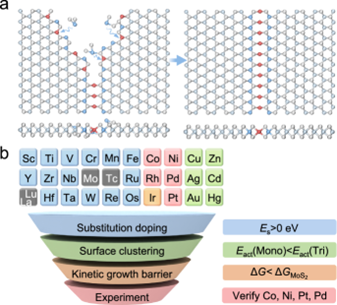Wen Qin, Shasha Guo, Zixi Liu, Peikun Zhang, Chao Zhu, Yao Wu, Ruixi Qiao, Zheng Liu, Wanlin Guo, Zhuhua Zhang
Nature Communications ,2025,1,1-9
Abstract: Single-metal-atom chains (SMACs) possess a variety of unique properties and functionalities but suffer from ambient vulnerability due to their delicate one-atom-width structures. While some SMACs can be effectively stabilized by nanochannel confining, it remains a pressing challenge to experimentally realize more versatile atomic chains with sufficient stability and extended length. Here, we propose a computational protocol to identify transition metals capable of forming SMACs along mirror twin boundaries in two-dimensional metal dichalcogenides. Taking MoS2 as a prototypical example, our thermodynamics and kinetics calculations indicate that Co, Ni, Rh, Pd, and Pt atoms can be enticed by the progressive formation of mirror twin boundaries to yield robust SMACs; whereas other transition metal elements tend to result in either substitutional doping or nanoclusters. These findings are supported by successful experimental synthesis of Co-, Ni-, Pd- and Pt-based SMACs using a chemical vapor co-deposition method, which exhibit high stability due to their covalent bonding with MoS2 grains. These results lay a solid foundation for investigating exotic transport behaviors within extremely confined channels.

Link: https://www.nature.com/articles/s41467-025-60127-3